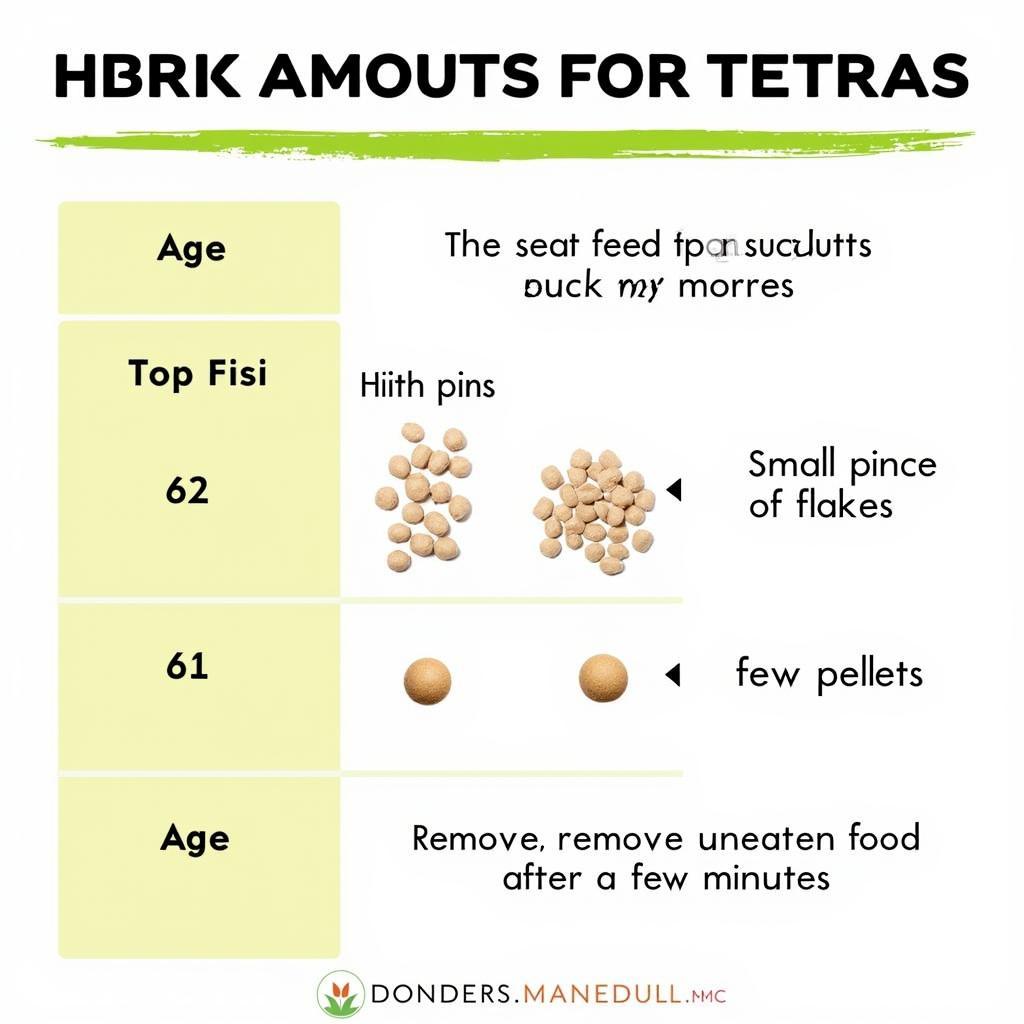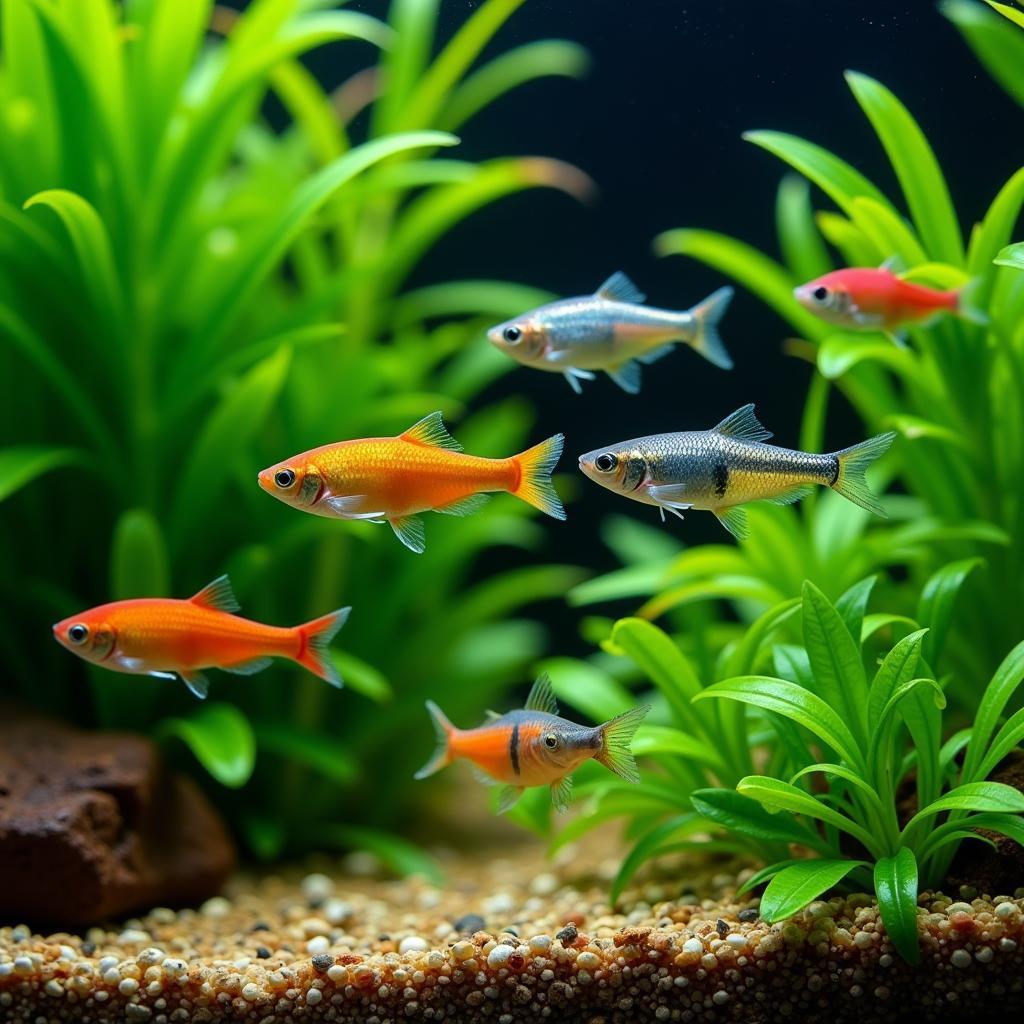Choosing the right Fish Food For Tetras is crucial for their health, vibrant colors, and overall well-being. Whether you’re a seasoned aquarist or just starting out, understanding the nutritional needs of these beautiful fish is essential for creating a thriving aquarium environment. This guide will dive deep into the world of tetra nutrition, covering everything from different types of fish food to feeding schedules and ensuring optimal health for your tetras.
Understanding Tetra Dietary Needs
Tetras are omnivores, meaning their diet consists of both plant and animal matter. In their natural habitat, they consume a variety of insects, crustaceans, algae, and plant material. Replicating this varied diet in your aquarium is key to keeping your tetras healthy. A balanced diet of high-quality fish food will boost their immune system, enhance their coloration, and promote active behavior.
Types of Fish Food for Tetras
Several types of fish food are suitable for tetras, each offering unique benefits:
- Flake Food: A staple for many aquarium fish, flake food is a convenient and readily available option for tetras. Look for flakes specifically formulated for tetras, containing a mix of protein and plant-based ingredients.
- Pellet Food: Pellets offer a more concentrated source of nutrients and sink slowly, making them ideal for mid-dwelling tetras. They also tend to create less mess than flake food.
- Live Food: Live foods like daphnia, bloodworms, and brine shrimp are excellent treats for tetras, providing a boost of protein and stimulating their natural hunting instincts.
- Frozen Food: A convenient alternative to live food, frozen options offer similar nutritional benefits. Be sure to thaw the food completely before feeding it to your tetras.
Choosing the Best Fish Food for Tetras
With so many options available, selecting the best fish food for your tetras can be overwhelming. Consider the following factors:
- Ingredients: Look for high-quality ingredients, such as whole fish meal, krill, and spirulina. Avoid fillers and artificial colors.
- Nutrient Profile: A balanced ratio of protein, fats, and carbohydrates is essential. Aim for a protein content of around 40-50%.
- Tetra Species: Some tetra species have specific dietary needs. For example, neon tetra food might differ slightly from the requirements of other tetras. Research your specific tetra species for optimal nutrition.
- Food Size: Choose food that your tetras can easily consume. Smaller tetras require smaller flakes or pellets.
How Much to Feed Your Tetras?
Overfeeding is a common mistake that can lead to poor water quality and health problems. Feed your tetras only what they can consume within 2-3 minutes, once or twice a day. Remove any uneaten food promptly to prevent it from decaying and polluting the water. For comparison, if you’re wondering how much food for a betta fish, the amount is usually quite similar.
 Tetra Feeding Guide
Tetra Feeding Guide
Maintaining a Healthy Tetra Diet
Beyond providing the right type and amount of food, maintaining a healthy tetra diet involves several other crucial factors:
- Variety: Offer your tetras a variety of foods to ensure they receive a broad spectrum of nutrients. Rotate between different types of flake food, pellets, and occasional treats of live or frozen food.
- Water Quality: Regular water changes are essential for removing waste and maintaining a healthy environment. Poor water quality can negatively impact your tetras’ appetite and overall health. This is especially important with Amazonian fish, as they thrive in pristine water conditions, hence the importance of amazonian food being high-quality.
- Observation: Pay close attention to your tetras’ eating habits and overall appearance. Changes in appetite, color, or behavior can indicate health issues and may require adjustments to their diet.
“A diverse diet is crucial for vibrant, healthy tetras,” says Dr. Emily Carter, a renowned aquatic veterinarian. “Just like us, they thrive on a variety of foods.”
 Healthy Tetra Tank
Healthy Tetra Tank
Conclusion
Choosing the right fish food for tetras is a vital part of responsible aquarium ownership. By understanding their dietary needs and following the guidelines outlined in this guide, you can ensure your tetras live long, healthy, and vibrant lives. Remember to offer a variety of high-quality fish food, feed them appropriately, and maintain excellent water quality for a thriving tetra community. neon fish food is a great place to start your research for specific species.
FAQ
- How often should I feed my tetras? Once or twice a day, only what they can consume in 2-3 minutes.
- What is the best betta fish food comparable to tetra food? what is the best betta fish food would depend on the individual betta’s needs, but high-quality pellets and flakes are a good starting point.
- Can I feed my tetras only flake food? While flake food is a good staple, a varied diet is best for optimal health.
- How do I know if I’m overfeeding my tetras? Uneaten food sinking to the bottom and clouding the water is a sign of overfeeding.
- What are the signs of a healthy tetra? Bright colors, active swimming, and a healthy appetite are signs of a healthy tetra.
- What should I do if my tetra stops eating? Check the water quality and consider offering a different type of food. If the issue persists, consult a veterinarian.
- Can I feed my tetras human food? No, human food is not suitable for tetras and can harm them.
Need more help? Contact us at Phone Number: 02437655121, Email: minacones@gmail.com Or visit us at: 3PGH+8R9, ĐT70A, thôn Trung, Bắc Từ Liêm, Hà Nội, Việt Nam. We have a 24/7 customer support team.